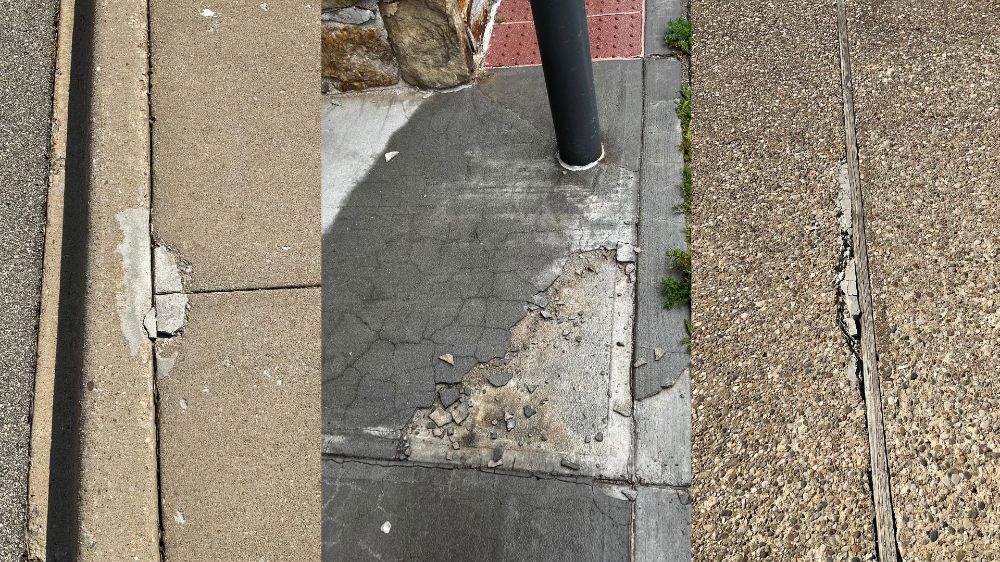
Is your concrete damaged and in need of repair? Learn all about the different methods of concrete repair available to you and their best applications.
Concrete can develop a heap of problems over time, but knowing how to fix them can keep you ahead of the curve.
Here at A-1 Concrete Leveling, our main goal is to help you preserve your concrete, and that starts with letting you know about all the options out there for its repair.
Over the last 30 years, we’ve learned what works and what doesn’t, and the situations where some repair strategies are better than others.
This article will walk you through the top concrete repair strategies, and give you a look at when we recommend each method.
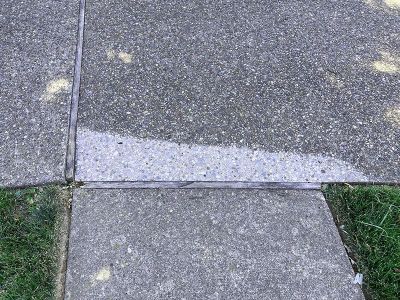
Concrete Grinding
Concrete grinding works by shaving down the surface of uneven concrete slabs. If your concrete has started to settle and trip hazards are popping up, grinding down the problematic areas can be a cheap and easy way to even out the surface and make the concrete safer.
However, concrete grinding eats into the concrete slab which makes it thinner, weaker, and more prone to cracking and freeze-thaw damage. Here at A-1 Concrete Leveling, we try to only use concrete grinding as a last-resort alternative to other concrete repair methods.
Best Uses for Concrete Grinding
Because concrete grinding risks damaging the concrete, we don’t recommend it unless:
- You have tree roots that will continue to grow and push the concrete slab up
- You are likely to replace the concrete in the future and potential damage isn’t a concern
- You don’t mind the aesthetics of shaved concrete
For eliminating trip hazards or uneven slabs, concrete leveling is usually a much better repair method.
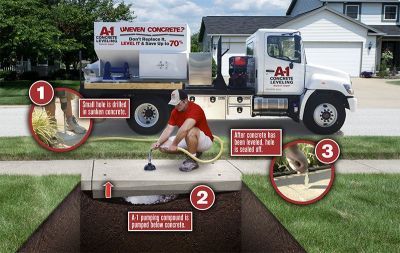
Concrete Leveling
Concrete leveling can be a solution for all sorts of concrete problems, like trip hazards, undesirable water flow, and pests, for example.
To level concrete, expert technicians drill strategic holes in the affected slabs, then pump a leveling compound into the voids under the sunken concrete. By doing it this way, you can preserve the concrete that you already have while saving a lot of time, money, and hassle.
Best Uses for Concrete Leveling
Concrete leveling is a great repair option for any problems around your home that come from settling concrete slabs. Some of the most common uses for concrete leveling are:
- Eliminating trip hazards around pools, walkways, sidewalks, driveways, and more
- Bringing uneven concrete steps back to a safe, even height
- Correcting sunken concrete slope and directing water flow away from house foundations or retaining walls
- Removing pests and preventing them from making another home under concrete
- Stabilizing and filling voids under concrete
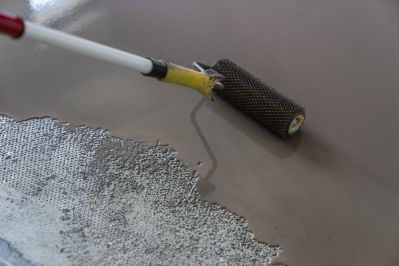
Self-Leveling Concrete
Self-leveling concrete is a material similar to cement that, when mixed with water, can be poured over existing concrete slabs to spread out evenly, creating a level surface.
Self-leveling concrete is a convenient way to even out the surface of concrete and eliminate any of its dips. Self-leveling concrete can be a great tool to use if the slab itself is level but the surface was originally poured with inconsistencies.
A mistake that many people commonly make is to use a self-leveling concrete compound in an attempt to level settled concrete slabs. Usually, for this method to be effective, the compound has to be applied too thick and will likely end up breaking up and crumbling. Also, there is a possibility that the slab itself will keep settling as the reason for the settling in the first place wasn’t addressed with the repair.
Best Uses for Self-leveling Concrete
Using a self-leveling concrete compound is best suited for:
- Filling in dips in the surface of concrete, like concrete floors in preparation for wood flooring
- Interior projects, as the temperature fluctuations outside can cause premature cracking
- Pours ¼ inch deep or less, although this can vary by compound
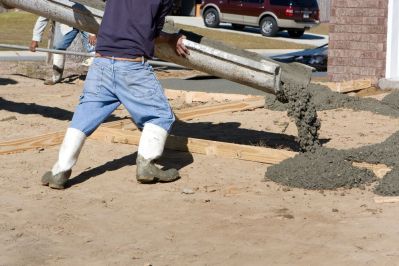
Concrete Replacement
Tearing out your concrete and replacing it is no small task, but sometimes it’s the best option depending on what you’re looking to get out of a concrete repair.
Getting new concrete poured comes with a lot of legwork, with everything from researching and carefully selecting a reputable contractor, to the demolition of the old concrete, installation of the new concrete itself, and waiting for it to cure the proper amount of time before use.
It’s worth keeping in mind, though, that concrete replacement comes with risks beyond the hassle and time commitment of installation. Bad batches of concrete, settling slabs, and torn-up lawns and landscaping are just a few of those risks.
Best Uses for Concrete Replacement
Concrete replacement can be a good option if you:
- Have underlying issues with your concrete and want to eliminate them
- Want to add certain features to your property, like a ramp or new steps
- Would like a clean slate with brand new concrete to maintain properly from the start
- Don’t mind having mismatched slabs, or replacing the entire property’s concrete instead
- Can’t level your concrete because it is too damaged
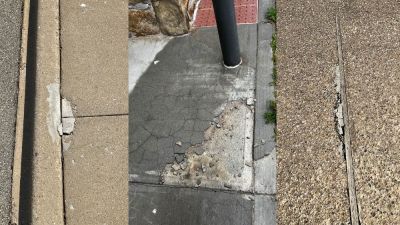
Concrete Patch Kits or Overlays
Concrete patch kits and overlays are materials that bond to damaged concrete, either to fill holes or resurface it.
Patching missing chunks in your concrete with a patch kit or overlay can be a cheap and effective way to eliminate trip hazards. Although this is true, patch kits and overlays are generally considered temporary solutions due to the expansion and contraction of the concrete caused by fluctuations in temperature.
Sometimes overlays and patch kits are used to cover up surface damage, like concrete spalling, but, again, this is a temporary solution. Pretty quickly the overlay will begin to chip away as the concrete underneath continues to deteriorate and the temperatures fluctuate.
Best Uses for Concrete Patch Kits or Overlays
Concrete patch kits or overlays can be a good temporary solution for:
- Trip hazards due to small chunks missing from concrete slabs
- Repairs not involving steps, where the patch could break off unexpectedly when someone walks on the step
- Concrete curbs
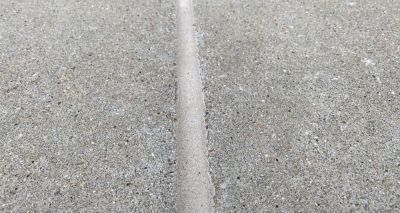
Concrete Caulking
Over time, concrete can develop cracks or breaks. Once these breaks start, they continue to worsen as freeze-thaw cycles occur. Unfortunately, there is no true solution to completely eliminate concrete cracks after they’ve started unless you completely replace the affected slab.
Although concrete caulking does not eliminate cracks, it can help prevent them from worsening and growing. By sealing up the pores in the concrete cracks, it prevents water from entering, freezing, expanding, then causing the crack to widen.
It’s also important to note that concrete caulking can help prevent slabs from settling. If applied to expansion joints and breaks in the slab, the seal helps keep water from running under the slab and washing out the soil holding it up.
Best Uses for Concrete Caulking
Concrete caulking is ideal for:
- Slowing the progression of cracks and breaks
- Helping prevent water erosion under concrete slabs
- Regular maintenance to upkeep the health of your concrete
Your Next Steps
Now that you know about the top repair options available to you and their recommended applications, you can decide which one is right for you.
Our Concrete Academy also has plenty of other resources about concrete repair and maintenance for you to continue your research. Here are some related topics:
- Concrete Replacement vs. Grinding vs. Leveling
- The Pros & Cons of Concrete Leveling
- How to Caulk Driveway Cracks
It’s also a good idea to discuss your options with a concrete professional. You can click the link below to request a free onsite consultation with A-1 Concrete Leveling:
Click Here to Find Your Nearest Location and Receive a FREE Estimate
While A-1 Concrete Leveling does not offer all the services mentioned above, our concrete experts will recommend the best course of action based on your situation.
Sarah Etler joined A-1 Concrete Leveling after receiving her Bachelor of Arts degree in English from Northern Kentucky University. As A-1's Content Marketing Manager, she works closely with industry experts to produce content that will best answer questions related to concrete repair and maintenance practices. Sarah loves living a life full of discovery and is excited every day to see what new things she can learn and share with those around her.
Topics: